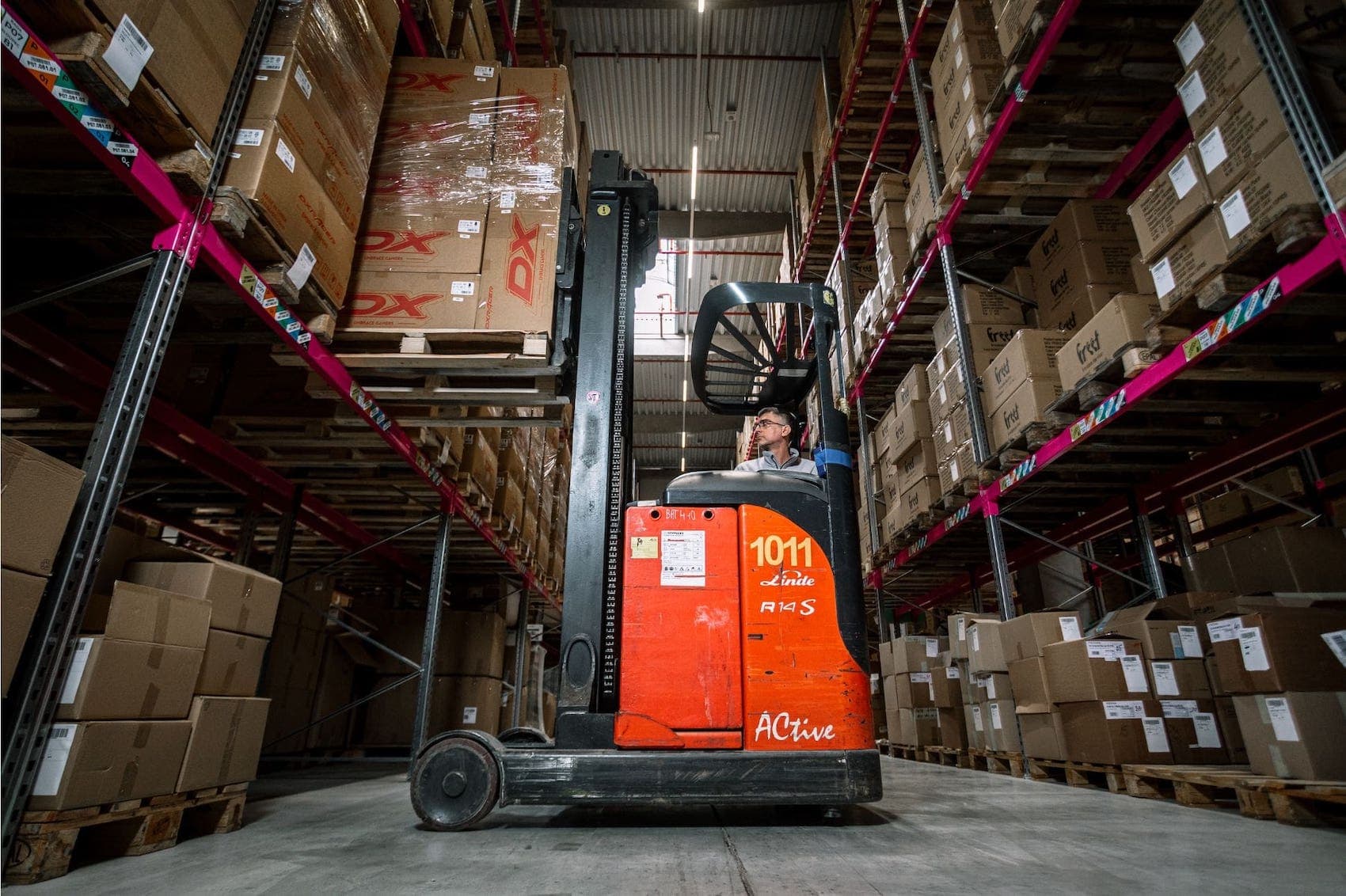Replenishment: Adapt to current order demand


Put yourself in the shoes of your (potential) customer… they spend a lot of time on the internet looking for the product they want. And when he finally finds it, he comes across an unpleasant discovery – the product is out of stock.
This scenario has a negative impact not only on your customer experience, but also on your revenue, as the customer is more likely to buy the product from a competitor.
Therefore, you need to constantly replenish your stock to keep the optimal amount of each product in stock. Replenishment is an integral part of inventory management and plays a key role in the e-commerce supply chain. It has a direct impact on both the lifetime value of your customers and the overall brand impression.
In our step-by-step article, you’ll learn why not to underestimate replenishment, how to approach it, and best practices or tips for managing it effectively.
What is replenishment
This is the process of stocking products into racks for immediate picking. Either within your warehouse from pallet positions for long term stock or directly from your partner supplier.
A sign of properly managed replenishment is that at any point in time when orders are received, the online store has sufficient but not excessive quantities of products which are then picked and dispatched.
Why is replenishment important in e-commerce?
Accuracy, speed, transparency. These are the key success factors of e-commerce logistics. Demands for these attributes from customers are constantly growing, in the Czech Republic it has been a long-established standard to deliver orders within the second working day of their creation (D+1 mode).
To meet this standard, it is important, in addition to operating in the appropriate software, to keep in the picking shelves such a quantity of products that on the one hand covers the current demand, but does not financially overload the storage and other costs.
Here we offer 3 reasons why it is important to constantly work with replenishment:
1. Avoid product unavailability
At the time of order receipt, a product may be unavailable for immediate picking for three main reasons:
- The product has not been ordered from your supplier/manufacturer.
- The product is part of the supply chain to the warehouse (so-called “in transit”).
- The product is not available for immediate picking in a “buffer” (long-term stock).
These reasons lead to either stock out or delayed handling and subsequent delivery of the order into the hands of the end customer. This results in a (propagated) negative customer experience for the online store.
HINT: Looking for a way to avoid running out of stock? Read our other articles on ordering products from suppliers. To replenish your inventory, define the ideal quantity (called the re-order quantity; ROQ) and the right time (called the re-order point; ROP). Work with and take into account your so-called safety stock when calculating.
2. Avoid excessive storage
This is more or less the opposite of the previous point. You need to work carefully with replenishing stock from your suppliers. Calculations must take into account the current demand forecast, which can vary significantly depending on, for example, seasonality of products, world events or planned marketing events.
While excess inventories will in most cases ensure immediate order processing, they are costly to hold. They involve both increased storage or equipment requirements, as well as extra ‘overtime’ in logistics processes, classically in receiving or loading, leading to increased demand for labour.
Excess inventories also bring with them another negative. Long-held goods may become unsaleable – they are simply no longer in demand or have passed their expiry date. For these reasons, excess inventory thus represents a significant hit to your bottom line.
Therefore, we recommend working with tools for optimal inventory management (ROQ, ROP and safety stock – see above), ideally with the involvement of a warehouse management system (WMS).
3. Reduce additional logistics costs
By properly managing your replenishment, you will also achieve further savings. By frequently ordering insufficient quantities, you overpay for shipping, and by ordering excess quantities, you put an unnecessary burden on your cash flow. This is doubly true if you import your goods from third countries, which also involves customs duties.
Other challenges come when you own multiple warehouses and deal with replenishment on multiple fronts. If you don’t have all the products in the required quantities at each warehouse, someone involved – you or your customer – always has to pay for the extra shipping. You send your customer an order either in multiple shipments or late, resulting in another negative experience. You pay more for the packaging process or packaging material, and what’s more, you increase the amount of associated waste and emissions.
Replenishment methods
The replenishment process can be managed in several ways. For example, it depends on the business model, the monthly order volume or the nature of the products. Below are the 3 most common methods of replenishment.
1. Re-order point
Set a re-order point at the level of each product. This is the point at which the quantity of a particular product drops to a defined level, which is correctly followed by a new order from the supplier. Work with software that automatically alerts you to this condition or automatically orders the ideal quantity for you.
The re-order point works with historical data and includes both on-demand inventory during the delivery period and safety stock, which you draw from until the new goods arrive in your warehouse.
2. Maximum refill method
This method is especially useful when you sell multiple products with high turnover. In this method, the stock of individual products is replenished to maximum levels on the picking shelves, e.g. when the warehouse operators are underutilized or during a temporary drop in demand. In this way, you continuously maintain a high turnover rate and efficiency of the picking staff.
Also, the level of maximum values for individual products on the picking shelves is variable over time, also based on historical data, trends, events and spikes. In other words, what applies to “pickle season” does not correspond to peak sales.
3. Periodic replenishment method
In this method, stocks are replenished at predetermined time intervals (e.g. once a week). The stock status is evaluated at set times regardless of the current status. This method is mainly used in warehouses with high storage capacity.
Tips for efficient replenishment
1. Invest in an adequate warehouse system
Want to match the big e-commerce players in speed, accuracy or transparency? In each of these cases, the days of “pencil and paper” or “Excel spreadsheets” should be numbered for you. How else are you going to keep up with the competition on these critical factors for (repeat) purchases?
The most important condition for effective replenishment is to have an absolute and complete overview of your holding in real time. Whether in stock or on its way to you. Only then are you able to continuously optimize your supply chain and achieve a positive shopping experience in the eyes of your customers. Not to mention the possibilities of setting up system automations that will be no less at your fingertips.
“The biggest value-add I see in the MySkladon client application is the accurate information about our inventory,” Simona Benkova, Process Manager at Skinners.
2. Work with data
If you have software that provides you with real-time data, you are able, for example, to easily find out the turnover of individual products. By doing this, you are safely able to answer questions about when and how often to replenish individual products from your long-term inventory.
A constant overview of your inventory is also the basis for better ordering from your suppliers. Stay in control of your economy, monitor trends, forecast demand, set relevant safety stocks, etc. Avoid unnecessary and financially unpleasant complications.
“With Skladon, we only pay for the storage space we actually use. If you have a good warehouse management set up and keep an eye on the turnover of goods, you can save tens of thousands per month,” Lucie Konečná, COO of nanoSPACE.
3. Manage your inventory strategically
Proper replenishment is only one part of optimal inventory management. You need to look at the process in a broader context. Define your re-order points, re-order quantity, regular inventory counts, standard procedures for receiving or stocking goods, etc.
Monitor, analyse and evaluate everything carefully. Any inefficiencies can affect your margins or the growth rate of your business.
“We recommend Skladon to anyone who wants to take their business to the next level. With Skladon, we have completely stopped worrying about logistics. We don’t deal with the work associated with warehouse management, inventory, employees, carriers, packing, returns, etc. The time and energy we gain can be spent on developing our business. The icing on the cake is that outsourcing logistics is cheaper for us than doing it in-house.” Martina Kovacova, co-founder of zKokosu.
Conclusion
The move to effective inventory management is a complex and costly step. For example, it requires significant investments in technology or optimization of logistics processes. It also involves a never-ending process of acquiring the expertise to find the next optimization steps, recruiting, training and managing warehouse staff, etc.
That is why we ask: “Is logistics an area you want to consistently focus on? Is it holding you back in your growth? Is it an obstacle to your international expansion?”
Join forces with Skladon. We offer our clients a complete overview for efficient inventory management and replenishment in the form of MySkladon. Analyse trends, set up automatic alerts or export detailed reports. Your logistics data is always online, in real time, 24/7 and available on any device with an internet connection. Get a long-term partner in us to help you open your borders to international expansion.
Are you worried that your hands will be tied by handing over your logistics or that an external logistics partner will not be adaptable to your ideas? With us, you are mistaken. Because an individual approach is what we pride ourselves on. We see how every online store is unique and has different needs. You won’t come across the term “standardization” with us.
“The biggest change I feel in the company is that I haven’t heard about logistics in six months.” Jakub Novák, CEO of Kilpi (10/2020).
